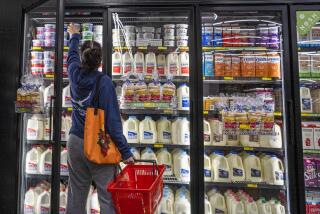U.S. Industrial Output Surges 0.8% in Nov.
- Share via
WASHINGTON — American industry’s output soared 0.8% in November, pushing the strain on factories, mines and utilities to the highest level in more than two years, the Federal Reserve Board reported Monday.
Normally, that would ring alarm bells at inflation-wary financial markets and at the Federal Reserve Board, where policymakers are scheduled to meet today to decide whether to raise or lower interest rates.
But not this time. The reason: Asia. The unraveling of the East Asia economic boom means U.S. companies are losing valuable export markets. And they face intensified competition from Asian manufacturers willing and able, because of sharp currency devaluations, to sell their products cheaply in the United States.
Most economists believe the disinflationary implications of what’s happening in East Asia will cause the Fed to hold interest rates steady into early next year. The central bank hasn’t changed the benchmark rate on overnight loans between banks--now at 5.5%--since late March.
In its report, the Fed said U.S. industry’s operating rate increased from 82.9% in October to 83.2% in November, the highest level since September 1995. But that doesn’t carry the inflation worries that it normally would, analysts said.
“Eighty-three percent is a key level of capacity,” said economist Mark Zandi of Regional Financial Associates in West Chester, Pa. “In the past, manufacturers started raising prices more aggressively at that point. But my sense is this time they’ll probably hold the line, if only because they’re getting stiff competition from Asia.”
To put the number in perspective, use of capacity averaged 82.1% from 1967 to 1996. It sank as low as 71.1% after the recessions of the late 1970s and early 1980s, and climbed as high as 85.4% at the end of the boom of the late 1980s.
Economists said they wouldn’t be surprised to see capacity use fall next year, for two reasons. First, U.S. corporations have been on an investment binge, buying everything from computers to production machinery. That has resulted in a big 4.7% increase in their capacity to produce over the last year.
Second, the robust production increases are coinciding with slacker domestic demand. Retail sales rose lethargically in November, after slipping in October and September. That probably presages an unwanted buildup of inventories of unsold goods.
The November production advance was the sharpest since July and marked the 20th month without a decline. It was propelled by increases in the output of autos and light trucks, up 5.5%; semiconductors, up 2.5%; and computers, up 1.8%.
(BEGIN TEXT OF INFOBOX / INFOGRAPHIC)
Industrial Production
Index:1987=100; seasonally adjusted
Nov.:127.3
Source: Federal Reserve Board
More to Read
Inside the business of entertainment
The Wide Shot brings you news, analysis and insights on everything from streaming wars to production — and what it all means for the future.
You may occasionally receive promotional content from the Los Angeles Times.










